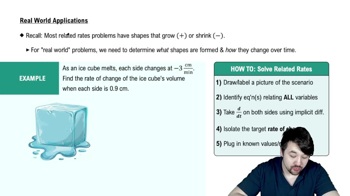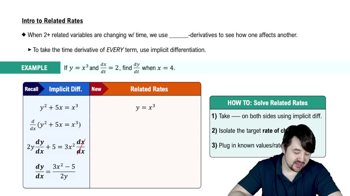Table of contents
- 0. Functions7h 52m
- Introduction to Functions16m
- Piecewise Functions10m
- Properties of Functions9m
- Common Functions1h 8m
- Transformations5m
- Combining Functions27m
- Exponent rules32m
- Exponential Functions28m
- Logarithmic Functions24m
- Properties of Logarithms34m
- Exponential & Logarithmic Equations35m
- Introduction to Trigonometric Functions38m
- Graphs of Trigonometric Functions44m
- Trigonometric Identities47m
- Inverse Trigonometric Functions48m
- 1. Limits and Continuity2h 2m
- 2. Intro to Derivatives1h 33m
- 3. Techniques of Differentiation3h 18m
- 4. Applications of Derivatives2h 38m
- 5. Graphical Applications of Derivatives6h 2m
- 6. Derivatives of Inverse, Exponential, & Logarithmic Functions2h 37m
- 7. Antiderivatives & Indefinite Integrals1h 26m
- 8. Definite Integrals3h 25m
4. Applications of Derivatives
Related Rates
Problem 3.6.7
Textbook Question
Define the acceleration of an object moving in a straight line.
 Verified step by step guidance
Verified step by step guidance1
Understand that acceleration is defined as the rate of change of velocity with respect to time. It can be expressed mathematically as a =
rac{dv}{dt}, where 'a' is acceleration, 'dv' is the change in velocity, and 'dt' is the change in time.
Recognize that velocity itself is the rate of change of position, which can be expressed as v =
rac{dx}{dt}, where 'v' is velocity, 'dx' is the change in position, and 'dt' is the change in time.
Identify that if you have a function for position, x(t), you can find velocity by taking the first derivative of this function with respect to time: v(t) =
rac{dx(t)}{dt}.
To find acceleration, take the derivative of the velocity function: a(t) =
rac{dv(t)}{dt} =
rac{d^2x(t)}{dt^2}, which gives you the second derivative of the position function with respect to time.
Consider the units of acceleration, which are typically expressed in meters per second squared (m/s²), indicating how much the velocity of the object changes per second.
Recommended similar problem, with video answer:
 Verified Solution
Verified SolutionThis video solution was recommended by our tutors as helpful for the problem above
Video duration:
2mPlay a video:
Was this helpful?
Related Videos
Related Practice






